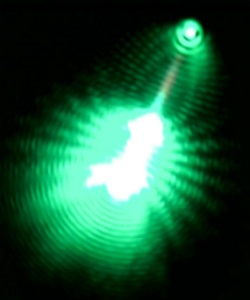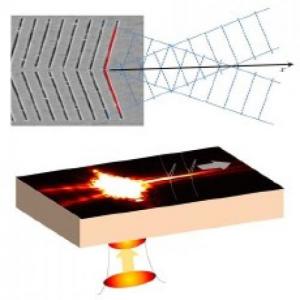Science
To Avoid Humans, Tigers Take Night Shift

A tiger’s eyes glow during the night on the same foot paths and roads humans use during the day to collect wood and grasses.
- Read more
- 375 reads
Sea Life Color Codes Food to Evade Danger

An example of bioluminescence: light emitted from a deep sea brittle star
- Read more
- 429 reads
NASA Mars Rover Curiosity's Arm Wields Camera Well

This view of the lower front and underbelly areas of NASA's Mars rover Curiosity combines nine images taken by the rover's Mars Hand Lens Imager (MAHLI) during the 34th Martian day, or sol, of Curiosity's work on Mars (Sept. 9, 2012).
- Read more
- 388 reads
Penn Researchers Make First All-optical Nanowire Switch

Laser light is emitted from the end of a cadmium sulfide nanowire.
- Read more
- 479 reads
Measuring mercury levels: Nano-velcro detects water-borne toxic metals

Coal plants like this one in West Chicago release mercury into the atmosphere which can end up in the water supply. This plant, the Crawford Generating Station, is among the last coal-fired plants to shut down in the city, and this move could help bring the already low mercury content in nearby Lake Michigan down even further.
- Read more
- 428 reads
Use of Nanotechnology Growing among Iranian Industrialists

Different Iranian industries, including the country's auto-manufacturing companies, are making an increasing use of nanotechnology in their products.
- Read more
- 413 reads
Needle beam could eliminate signal loss in on-chip optics: Harvard researchers create a light wave that propagates without spreading

Top: A micrograph and diagram of the metallic gratings that produce the needle beam. Bottom: An approximation of the experimental setup. A laser is focused from the glass substrate side onto the device. Once the non-diffractive surface wave is created, detailed information on its intensity distribution is gathered using an ultrahigh-spatial-resolution near-field scanning optical microscope.
- Read more
- 421 reads
Rust Never Sleeps: Berkeley Lab-led Observations of Electron Hopping in Iron Oxide Hold Consequences for Environment and Energy

Iron oxide (rust) is a poor electrical conductor, but electrons in iron oxide can use thermal energy to hop from one iron atom to another. A Berkeley Lab experiment has now revealed exactly what happens to electrons after being transferred to an iron oxide particle.
- Read more
- 473 reads
Proteins barge in to turn off unneeded genes and save energy

A few Angstroms make all the difference. The CueR protein binds to DNA at the start of a gene that protects against copper poisoning. When copper atoms bind to CueR, the protein changes shape just enough to twist the DNA - such a small distance that it can't be drawn in two dimensions - to turn on transcription of the gene. When the gene is no longer needed, the original form of CueR unceremoniously kicks the copper-bound form away, turning off transcription quickly to save energy.
- Read more
- 407 reads
Human Rights
Fostering a More Humane World: The 28th Eurasian Economic Summi

Conscience, Hope, and Action: Keys to Global Peace and Sustainability

Ringing FOWPAL’s Peace Bell for the World:Nobel Peace Prize Laureates’ Visions and Actions

Protecting the World’s Cultural Diversity for a Sustainable Future

Puppet Show I International Friendship Day 2020


